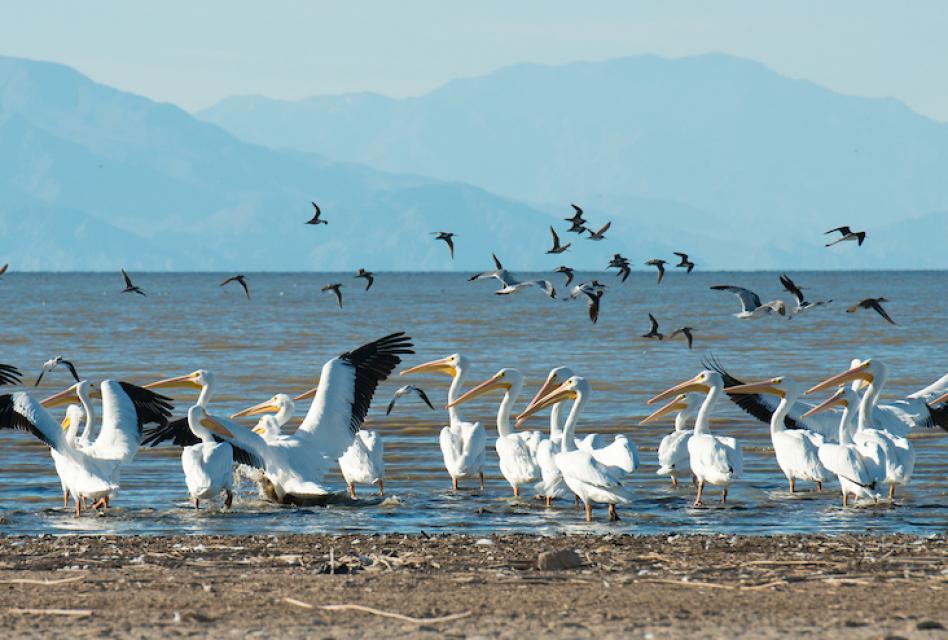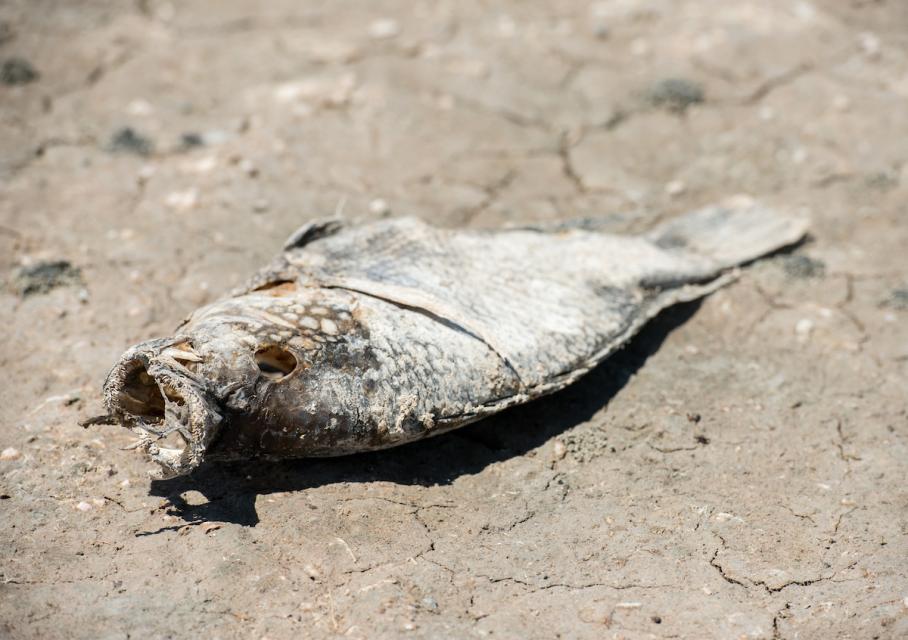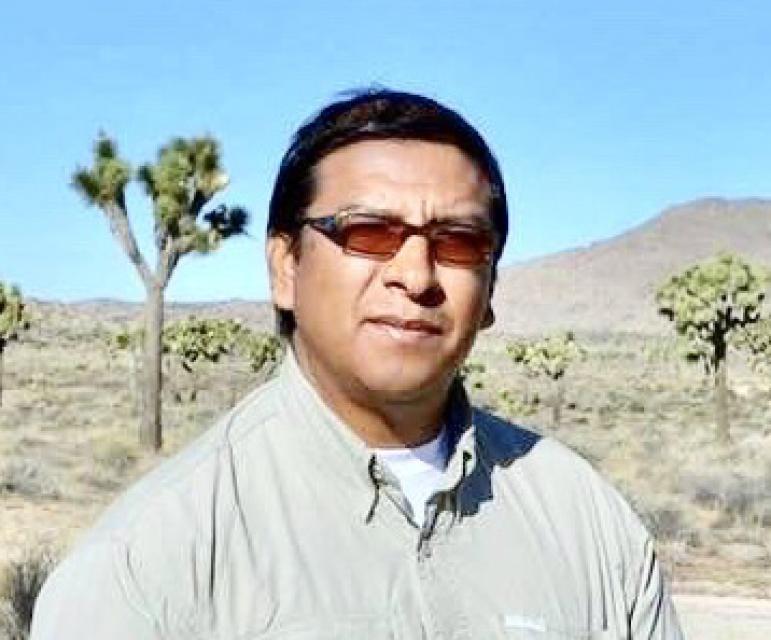Dust suppression, habitat are key elements in long-term plan to aid the Salton Sea, whose ills have been a sore point in Colorado River management.

By Gary Pitzer
Out of sight and out of mind to most people, the Salton Sea in California’s far southeast corner has challenged policymakers and local agencies alike to save the desert lake from becoming a fetid, hyper-saline water body inhospitable to wildlife and surrounded by clouds of choking dust.
The sea’s problems stretch beyond its boundaries in Imperial and Riverside counties and threaten to undermine multistate management of the Colorado River. A 2019 Drought Contingency Plan for the Lower Colorado River Basin was briefly stalled when the Imperial Irrigation District, holding the river’s largest water allocation, balked at participating in the plan because, the district said, it ignored the problems of the Salton Sea.
“The Salton Sea has to be acknowledged for what it is — a serious public health and environmental crisis that can and will have long-term, devastating consequences across the region,” said Norma Galindo, president of the irrigation district’s board of directors. “It is an indispensable part of the Colorado River system, not an invisible one. Its decline simply must be addressed.”
The Salton Sea “is an indispensable part of the Colorado River system, not an invisible one. Its decline simply must be addressed.”
~ Norma Galindo, Imperial Irrigation District board president
The state of California, long derided for its failure to act in the past, says it is now moving full-bore to address the sea’s problems, with ambitious plans for wildlife habitat expansion and dust suppression.
“We are moving as fast as we can and are fully committed to doing the really good things that we need to be doing at the Salton Sea to address the real issues down there,” said Arturo Delgado, assistant secretary for Salton Sea policy at the California Natural Resources Agency.
Agencies with a stake in the Salton Sea are racing to cope with twin problems: suppressing dust from the sea’s receding shoreline to protect the small communities that ring the lake while enhancing areas that are essential to fish and birds. In a state where more than 90 percent of historic wetlands have been lost, the Salton Sea is a vital stop for birds along the migratory route of the Pacific Flyway. All told, more than 400 bird species make regular use of the Salton Sea.
A question of urgency
As California’s largest lake, the Salton Sea is unique. More than 230 feet below sea level, it has no natural outlet and is twice as salty as ocean water. For about 20 years, the sea’s water level has steadily declined, further concentrating the salinity.

Protecting and restoring the sea’s ecological values has been a longtime aspiration, but progress has been achingly slow. State plans, some of them ambitious in scope, have come and gone while the sea deteriorates.
“There is no sense of urgency,” said Frank Ruiz, Salton Sea program director with Audubon California. “The Salton Sea has never been a priority for the state or any other entity outside the area.”
Gov. Gavin Newsom’s administration has pledged to make progress. Getting there includes the laborious tasks of siting, designing and building dust suppression and habitat projects and convincing skeptical locals that inroads will be made where other efforts have fallen short. The state has set the lofty goal of creating 30,000 acres of habitat and dust suppression by 2028.
Delgado said he and his colleagues are up to the challenge.
“When I came in eight months ago, we took stock of our current situation and started developing a realistic timeline based on when we could possibly complete this work,” he said. “It’s a very aggressive timeline but it’s doable.”

The action plan includes working with local partners such as the Imperial Irrigation District, which has long chafed at the pace of progress at the sea. Earlier this year, the state and Imperial Irrigation District completed the Bruchard Road Dust Suppression Project on about 125 acres of exposed playa at the sea’s southern edge.
Imperial Irrigation District opposed participating in a Colorado River Lower Basin Drought Contingency Plan last year because it did not adequately address the sea’s plight. The federal government’s lack of financial commitment to the sea “has been the single biggest impediment to a Lower Basin Drought Contingency Plan that could do what Imperial and all other Colorado River contractors need it to do, which is reduce the risk of reaching critical elevations at Lake Mead,” said Galindo, the district’s board president. Earlier this month, in its legal challenge to the Drought Contingency Plan, the district reaffirmed its view that the drought plan should be suspended until the sea’s environmental needs are assessed.
Making something bad better

Imperial Irrigation District signed on to a landmark 2003 water transfer between the district and San Diego, known as the Quantification Settlement Agreement (QSA), to help California reduce its overuse of Colorado River water. One effect of that was a significant curtailment of the Salton Sea’s inflow from farm irrigation. As part of the agreement, the state committed to pursuing a restoration plan for the sea while the district contributed mitigation water through 2017. However, a long-term, comprehensive Salton Sea management program has never fully emerged, due in part to the expense.
The transition from the Gov. Jerry Brown administration to the Newsom administration in 2019 brought renewed focus to the sea. However, tangible results remain elusive, said Tina Shields, Imperial’s water manager.
“When you are 15 years behind, you are not just going to wave a magic wand and suddenly have all of these projects completed,” she said.
Identifying and remedying problem areas can be a checkered process, Shields said. Potential projects often face extensive hurdles. “You’d think it would be easy to permit a mitigation project, something that’s going to make something bad better,” Shields said. “But it’s just as complicated as building a Walmart in Temecula because you have to bring in all of those wetlands permits.”
The state’s plan hinges on near-term and long-term actions that improve all elements of the sea, including evaluation of a possible “whole sea” solution that would import ocean water from the Sea of Cortez to stabilize the Salton Sea. Adding water from a source as reliable as the Pacific Ocean would seem to be an obvious solution, but it’s not that easy.
“It’s all about the salt,” said Phil Rosentrater, executive director of the Salton Sea Authority, the joint powers authority of local leaders that works with the state to revitalize the sea. “Water is certainly a critical part of the equation for a more sustainable sea, but salt management is the difference between life and death for the ecosystem.”
“Everybody in the Western Hemisphere needs to care at one level because it’s an integral and critical part of the Pacific Flyway. If we lose the Salton Sea, we lose one of the last wetlands for migrating birds.”
~Celeste Cantú, former executive director, State Water Resources Control Board
Teed up for work this year are plans by the state to launch 3,800 acres of habitat for the fish-eating birds that are most affected by a crashing sea. Rosentrater said his agency is poised to leverage state investments with federal dollars to work on habitat and dust suppression projects.
Air quality is a significant issue. At times the rotten egg smell caused by the sea’s hydrogen sulfide emissions has spurred complaints from people in Simi Valley, 200 miles away.
Dust suppression is paramount. The sea’s inflow from farm runoff has fallen substantially since 2003, accelerating the sea’s retreat, increasing salinity and exposing more shoreline, especially in the shallower areas. What’s left is a chalky playa that stirs into blinding clouds when the wind blows. The dust is laden with toxic elements, posing further harm to local communities, many of them disadvantaged and already struggling with high asthma rates.
The situation does not sit well with Imperial County, which last year declared a local state of emergency at the sea to address the dust suppression issue. Last month, on June 23, the county’s Air Pollution Control District slapped notices of violation on the U.S. Fish and Wildlife Service and the Imperial Irrigation District for failing to address ongoing dust problems at the sea’s southeastern edge.
Projects to address the problems take time and resources and must navigate the regulatory permitting process. Furthermore, because the state is not a major landowner or water rights holder in the region, it must secure easements and needed water, said Delgado, the Resources Agency official.
The imperiled sea
Situated in an ancient lakebed that naturally filled with Colorado River water on occasion through the centuries, the Salton Sea of today came to life in the early 1900s when river water blew through an irrigation ditch. By the time the flow stopped, it filled a basin 45 miles long, 17 miles wide, and 83 feet deep.
In the 1950s and 1960s, it was touted as a Riviera-like destination for sun lovers and water enthusiasts, but that destiny was short-lived. Since then, the Salton Sea has assumed an other-worldly aura with occasional spikes of foul odor and dead fish.
The Salton Sea’s role as one of the few remaining refuges for migratory waterfowl raises its profile substantially.
“Everybody in the Western Hemisphere needs to care at one level because it’s an integral and critical part of the Pacific Flyway,” Celeste Cantú, former executive director of the State Water Resources Control Board, said in an interview. “If we lose the Salton Sea, we lose one of the last wetlands for migrating birds.”
A native of Calexico in the Imperial Valley, Cantú moderated a panel on the state’s response at the October 2019 Salton Sea Summit.
The state has outlined short-term and long-term actions for the sea, targeting habitat creation and more than 8,000 acres of dust suppression projects by the end of 2022.
Shields, with Imperial Irrigation District, sees both sides of the equation – the state’s efforts and the frustration of local residents tired of inaction.
“I think the state’s making progress,” she said. “The problem is for all the effort they are putting into it now; the general public isn’t going to see that progress for two or three years. Until you get the contractors out there, the trucks moving dirt, they [the general public] don’t get the process behind designing and going out to bid and staffing up.”
The big picture
Since the signing of the QSA, the clock has been ticking at the Salton Sea, which will keep demanding the attention of everyone concerned about and responsible for public health and ecological preservation.
Then there is how the sea will be accounted for in the grander vision of Colorado River management. Imperial Irrigation District hopes the sea “will have a much higher profile and receive the attention it needs in relation to the region’s collective management of the Colorado River,” said Galindo, the district’s board president.

Forging a sustainable path for the Salton Sea is “a must-have” for Imperial, Galindo said. She added that the district’s twin goals of being a good citizen on the Colorado River and seeing a sustainable Salton Sea are compatible and “linked together, hydrologically and morally.”
Rosentrater acknowledged the inertia of the past and the difficulties with finding the right solutions. There was a time when people believed the sea’s problems were insurmountable and not worth the investment of time or resources. That’s changed.
“When you get down to it, doing nothing turns out to be the most costly and reckless of all options,” he said. “That was the conversation of a decade ago, let the thing die and stop trying to prop it up. We have come a long way from there to realizing if we let it go, it’s catastrophic.”
Reach Gary Pitzer: gpitzer@watereducation.org, Twitter: @GaryPitzer
Know someone else who wants to stay connected with water in the West? Encourage them to sign up for Western Water, and follow us on Facebook, Twitter and LinkedIn.
This story was published by Western Water on July 17, 2020.
The Water Desk’s mission is to increase the volume, depth and power of journalism connected to Western water issues. We’re an initiative of the Center for Environmental Journalism at the University of Colorado Boulder. The Water Desk launched in April 2019 with support from the Walton Family Foundation. We maintain a strict editorial firewall between our funders and our journalism. The Water Desk is seeking additional funding to build and sustain the initiative. Click here to donate.





